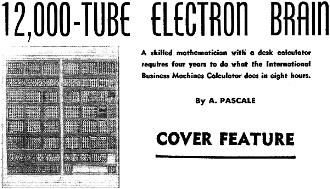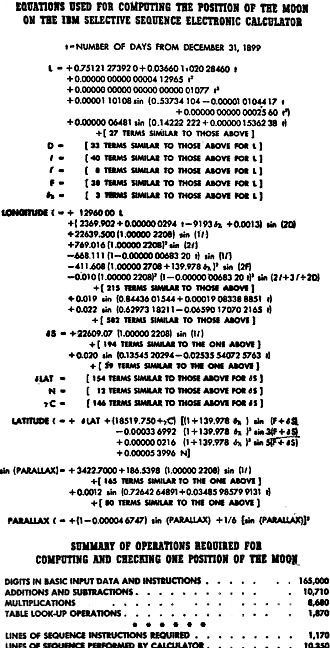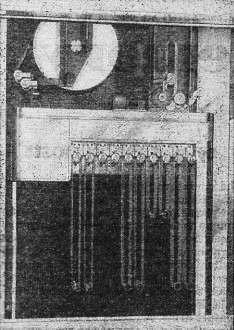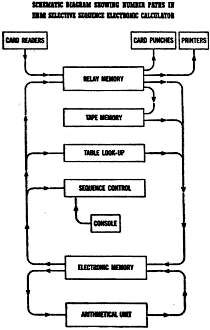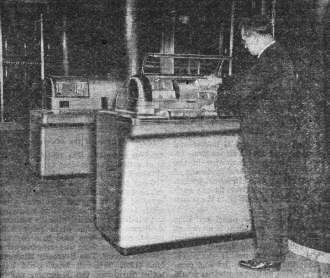12,000 Tube Electron Brain
|
|
This Radio-Craft magazine article starts out stating, "A skilled mathematician with a desk calculator requires four years to do what the IBM Calculator does in eight hours." That was in 1948. A recent headline read, "Given the task of finding a pattern in a seemingly random series of numbers, Google's quantum computer produced an answer in 3 minutes and 20 seconds. It estimates that the Summit supercomputer here at the Oak Ridge National Laboratory in Tennessee would take 10,000 years to complete the task. The IBM 12,000 vacuum tube computer performed its calculation for an improvement factor of [(3 yr • 8760 hr/yr) + (1 yr • 8784 hr/yr)] ÷ 8 hr = 4383 (4.383 thousand). The Google quantum computer performed its calculation for an improvement factor of (10,000 yr • 31557600 s/yr) ÷ 200 s = 3.15776E11 s ÷ 200 s = 1.57788E9 (1.57788 billion -- or milliard). The IBM computer occupied nearly 50,000 square feet. Google's computer occupies about 50 square feet (maybe a little more including support equipment like cooling and external interface computer). That's quite an evolution in computing power in seven decades: 360000:1 in 1000th the volume and significantly less electrical power. In another seven decades computers will figure out how to make humans smarter and faster. 12,000 Tube Electron Brain A skilled mathematician with a desk calculator requires four years to do what the International Business Machines Calculator does in eight hours.By A. Pascale Would you like to compute the position of the moon involving the equations shown below in seven minutes? Yet it took only seven minutes, with the help of 12,000 electronic tubes, 21,400 relays and 40,000 pluggable connections, all at the disposal of the scientist, to work this problem on the IBM Selective Sequence Electronic Calculator. Without this machine it would have taken 3 weeks. The entire machine is made up of card reading tubes. sequence tubes, sequence relays, table look-up (for consulting reference tables), relay memory, meters, control relays, power distribution, tape memory, arithmetical unit, sequence interlocks, electronic memory, printers, card punches, and card readers, in addition to the control desk and pulse generator shown on our front cover. These are all housed in a specially-designed room, 40.6 feet wide x 86.6 feet long x 14 feet high, the walls of which are completely lined with panels of vacuum tubes and relays. These walls - with a number of pieces of floor apparatus, such as printers and control consoles - actually are the machine. Equations used for computing the position of the moon on the IBM Selective Sequence Electronic Calculator The calculating element of the machine adds, subtracts, multiplies and divides the numbers it receives. The machine can make 3,500 additions or subtractions of 19-digit numbers in a second; 56 multiplications of 14-digit numbers in a second, and 30 divisions of 14-digit numbers in a second. It has a storage capacity of 400,000 digits in tubes, relays and punched tapes. When punched cards are used for storage the capacity of operation becomes virtually unlimited. Instructions are' given to the machine by the scientist on punched cards or one continuous card-stock tapes. The tapes are prepared in one of two ways - either by the machine itself or with an auxiliary tape punch which transcribes data from punched cards. When the instructions are given on punched cards the numerical data is converted electronically from the original decimal form to the binary-decimal form in which each digit is represented by a combination of the binary numbers, 8, 4, 2, 1, used by all the new giant electronic calculating machines. As soon as the numbers are converted to the binary system, masses of neon lights carryon a fire-fly flickering at stupendous speed, while very intricate calculations are being made within the machine. The innocent onlooker is virtually overwhelmed by this display. The machine follows the instructions on the cards or tapes and stores each intermediate result in a memory unit for later use in the course of the calculation. There are three means of storing numbers: electronic tubes (trigger circuits using 12SN7 tubes), relays and tapes. The relay and tape memory units are provided for general storage when large capacity is the dominant requirement. Electronic memory units are used in connection with the arithmetical unit where the need for speed predominates. But though the electronic system is more rapid) it cannot be used to the exclusion of tape and relay systems. If the present storage capacity of the machine, which is over 400,000 digits, were to be stored in electronic circuits it would be impracticable to house the machine in one building. Not only does this machine add, subtract, divide and multiply, but it will also look up logarithm, trigonometric and other tables. If a table has to be referred to in the course of the calculation, the machine starts the tape of the desired table spinning. When the reference is reached, an electronic impulse stops it. The number then is stored in the memory section for future use. Punched-hole memory units use long tape rolls. Schematic diagram showing number paths in IBM Selective Sequence Electronic Calculator The data for all computations and results obtained must flow to and from the arithmetical unit through any one of hundreds of channels throughout the machine, such as the reading and recording units and the great reservoir of stored results. Eight separate channels, each capable of transmitting simultaneously 19 decimal digits and an algebraic sign, lead to and from the arithmetical unit. Traffic is directed along these channels to and from the other units by IBM electromagnetic relays. One of these relays, which is slightly larger than a conventional vacuum tube, can change twelve independent circuits in a few thousandths of a second. For some special problems it may even be desirable to change the whole mode of operation of the machine. This can be done in a few minutes by means of automatic control panels. About 40,000 pluggable connections on these control panels can be changed in units in a remarkably short time. Problem results may be recorded either in punched card or in printed record form, or if desired, in both forms. Since the machine is being utilized primarily for research purposes and because calculation proceeds at such a high speed, it is necessary that the scientists know at all times what results are being obtained, so that modifying instructions may be injected whenever necessary. Provision was made, therefore, for the continuous printing of results throughout the calculation. The console, or operation indicator and control desk (shown on the front cover) is used for keeping a check on the operation of the machine. Have you stopped to consider what an immense servicing problem it must be to locate a burned-out filament in this maze of vacuum tubes? The control desk is useful for trouble shooting. If a tube burns out, or anything else goes wrong mechanically, neon lights in the panel on the control desk assist the operator in finding and diagnosing the trouble. A check is then made in the faulty section, the trouble repaired, and the machine goes on with its work. Of course, the trouble will be discovered only when the machine has to make use of that particular panel in the course of the calculation. The machine requires 180 kilowatts of electrical energy. All the alternating current it uses is rectified by a large battery of rectifier tubes housed in cabinets in a room beneath the calculator. A large air-conditioning system is provided. It has a cooling capacity approximately equal to that required to air-condition completely a building containing 250,000 cubic feet of space. The system is capable of dissipating 200 kilowatts of heat. The calculator is divided into three fire zones, each equipped with automatic temperature-detecting devices. Control of fire after detection can be either manual or automatic. Full release of the fire-extinguishing apparatus would discharge 32 tanks of CO2 into the calculator units. The air conditioning and power supply would shut off automatically if gas were discharged. The instrument was built at a cost of $750,000. Many branches of industry will be greatly aided by this machine. In certain commercial statistical fields calculations have to be made where complicated sequences of operations must be handled one at a time. The operations can be so speeded up as to perform calculations which now are considered impractical due to the amount of time that would be involved. The scientist will be the one most aided by it. What once took scientists years upon years to work out, now can be done in a few hours, freeing him for further research. Greatest of all may be the effect of this new computer on the progress of atomic research. By performing the complex and laborious calculations required in the study of the atom, it will be a dominant factor both in keeping this country well ahead of all competitors in the military development of the atom and in speeding the day when atomic power will be available to peaceful arts and industry. But, it cannot, and never will, replace the human scientist as its purpose is only to follow his commands. If the incorrect instructions are given to it, it will follow them. The scientist is supreme over the great electronic calculator, which is his child to assist him in exploring the ever-profound depths of science. As President Thomas J. Watson of IBM said: "This machine will assist the scientist in institutions of learning, in government, and in industry, to explore the consequences of man's thought to the outermost reaches of time, space and physical conditions."
Posted March 29, 2024 |
|

